Your browser is out-of-date!
Update your browser to view this website correctly. Update my browser now
Home › Reviews › Mobilvetta › K-Yacht Tekno Line › MH-85

Mobilvetta K-Yacht Tekno Line MH-85 2017
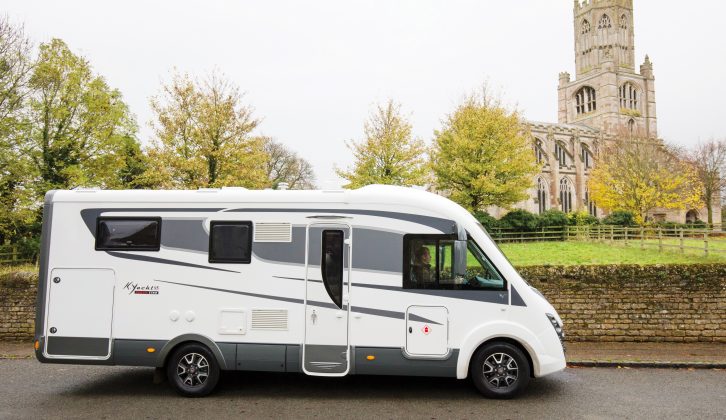
Published: August 16, 2017
You can indulge in A-class luxury and style on a 3500kg chassis with this Mobilvetta K-Yacht Tekno Line MH-85 – but just how tempting is it?
Mobilvetta is one of a handful of motorhome brands (the others being Itineo , Rapido and Pilote , at least in Essentiel spec) that offers A-class ’vans at prices close to what ordinary folk can afford.
This Mobilvetta is a good £10k cheaper than Adria and Bürstner models with similar layouts, although they include Alde heating and a slightly higher specification.
But there are enough innovations inside Mobilvetta’s K-Yacht MH-85, including the underfloor heating and the clever kitchen, to make this a motorhome you can really grow into, even if there are one or two niggles – like the night-lights.
With Marquis Leisure’s input, you get a much more UK-friendly spec too, but you would be wise to opt for the free chassis upgrade, driving licence permitting, of course.
The kitchen has been cleverly thought out You can get a good amount in the rear garage, plus there are handy storage nets and a light/torch
Lots of lighting inside is great, but we felt it was a bit too much – especially when trying to turn them all off There’s so much storage space that it’s easy to overload the ’van!
Mobilvetta may sound and look Italian, and although it is Italian built, mamma mia , as with so much else in the motorhome industry these days, it is actually part of a much larger multi-national concern – in this case, the French-owned Trigano Group.
Despite such support, it had been largely absent from the UK market for most of the past decade, a result of the late-2000s financial crisis that saw the Italian motorhome market contract by as much as one fifth.
That was up until the start of the 2017 season, though, when the UK’s biggest motorhome and caravan dealer network, Marquis Leisure, keen to add an A-class brand to its portfolio, brought Mobilvetta back to British forecourts.
Don’t forget that Marquis is already enjoying no little success with Benimar , itself another Trigano brand.
So far, potential UK buyers have only seen three models from the brand’s K-Yacht Tekno Line , which, surprise surprise, has been designed to incorporate elements of nautical style.
Earlier this season, we tested the K-Yacht MH-80 , which carries an innovative rear-lounge layout.
Now we’re taking the K-Yacht MH-85 , with single beds in the back and a drop-down double bed over the dinette, for a spin through rural Northamptonshire and a thorough live-in test.
The cooking area is one of the best we have seen in recent times
A front dinette is usually going to be a space challenge in a motorhome with fixed beds.
Here in the Mobilvetta K-Yacht Tekno Line MH-85 it is less so, because the designers have found enough space to incorporate an L-shaped seat and a small side seat to the right of the habitation door.
But even if our team-mate did fall asleep on the move, these seats are really only moderately comfy when the motorhome is stationary. The main bench in particular seems very upright.
You would probably be more inclined, as we were, to use the swivelled cab seats if it is just the two of you. They would certainly give you a prime position for watching the TV if you were to install one on the bracket fitted to the left of the habitation door.
The table is fully adjustable, but we found it was always a little far out from the side seat, which, like the bench, is not super comfortable.
The seat is, however, a useful place for putting on any shoes you might keep in the nearby cubbyhole in the double floor.
The lounge is adequately heated with one vent to the side and another by the door. There is one mains socket in this area, which is a bit of a squeeze to get to as it is under the L-shaped seat, but the sockets in the kitchen are nearby.
A rooflight keeps this area bright and airy, even taking the drop-down bed into account, and alongside those LED striplights there are plenty of LED spotlights, including four in a row by the drop-down bed’s curtain, plus two by the door that come on automatically as you enter the motorhome.
The drop-down bed has speakers in its base, too.
The cooking area in the Mobilvetta K-Yacht Tekno Line MH-85 is one of the best we have seen in recent times. There is only a three-burner hob, but it is cleverly tucked into the corner, and there is a large sink with a cover that alternates as a chopping board and fits into a slot on a rail that runs along the top of the partition by the sink.
That’s a useful idea, although we would be tempted to swap the board’s position with the paper towel holder that also sits on this rail so that the board is directly over the bin behind the sink, and all food waste can simply be scraped off and dropped in.
The whole work surface is well lit, with a 12V and mains socket next to the light switch, and there’s even an extractor fan.
There’s another potential resting place for the chopping board on top of the cutlery tray under the worktop. Here, it can form an extension flap.
Two large drawers and an ingenious shelving system that telescopes out next to them means that there is plenty of room for even quite large pans and utensils.
Up above, the two overhead lockers are also large.
Having so much space to hand makes you wonder why the designers bothered with the tiny apothecary shelf across the aisle.
Next to it is a three-way 150-litre Thetford fridge, and a SMEV oven and grill above that – it will be a little high for some, though.
The washroom is split across the middle of this Mobilvetta motorhome.
A stylish-looking stainless-steel basin with a soap dispenser and mug embedded into the worktop around it, and two differently angled mirrors behind it, takes up one side, along with a swivel toilet with toilet roll holder and brush.
There’s also one overhead locker and a cupboard under the basin that is partly obscured by a thin towel rail.
This area, which is partitioned off by a tambour door, also has a window and a roof vent with a fan.
Strangely, you won’t find the latter in the shower cubicle across the aisle, which also only has one drain hole – a sign, perhaps, that this is an affordable A-class.
But the shower head itself looks ultra-modern, and there are solid metal shelves for stowing all your lotions and potions.
The whole washroom area can be partitioned off from the front lounge and kitchen by means of an elegant Japanese-style door.
The comfortable fixed beds at the rear are reached by steps – each measures 2.03 x 0.83m (6’8″ x 2’9″).
The beds are reasonably high, which means you don’t have a huge amount of headroom. But as the mattresses themselves can be raised at the pillow end, support is available for sitting up in bed.
Sleepers get spotlights for reading, while in the middle between the two beds is a very large wooden shelf that could easily serve as a resting place for books.
If you would rather cuddle up for the night, you can pull out an extension over the steps and insert a couple of infills to create a double bed.
The 1.88 x 1.33m (6’2″ x 4’4″) drop-down double bed over the cab was a little more complicated to position than we had expected.
The folded cab seats need to rest an inch or so before their forward-most position, not right at the end. Trying to work this out inevitably involved accidentally sounding the horn, so you might need to be careful if you are putting this bed down late at night.
Once it is deployed, though, you get a bed that is an accessible height, and comes with spotlights and a rooflight.
You’re certainly not short of space for clothes in the MH-85.
Along with six overhead lockers in the bedroom, there are two huge wardrobes under the bed, one with a hanging rail and the other with two large shelves.
There are also clever sock shelves in the curve of the wardrobe doors, while two of the steps open up for storage.
The designers have made use of the double floor – not just externally with those two lockers, but also internally with cubbyholes along the centre of the ’van. The one by the fridge is cleverly sub-divided to take large drinks bottles – molto buono!
The excellent garage, meanwhile, has two doors, a light you can remove to use as a torch, and netted storage across the back. It is big enough to take bikes upright.
The only trouble is the modest user payload of 342kg – fill up all the available storage spaces and you’ll end up being overweight.
Buyers with C1 entitlement on their driving licences can get around this by opting for a chassis upgrade to 3650kg, which is free of charge.
Technical Specifications
Related reviews.
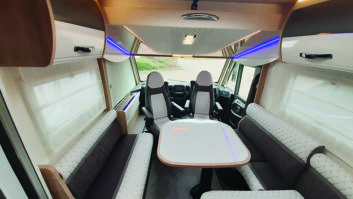
Mobilvetta Tekno Line K Yacht 59 2022
This compact, couples-friendly motorhome benefits from some impressive touches, at a price that's right
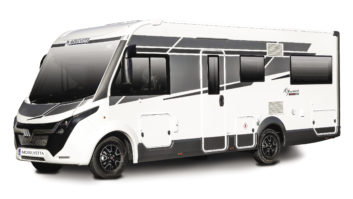
Mobilvetta Tekno Line K Yacht 95 2022
The rear-lounge layout of this comfortable and spacious four-berth should appeal to UK buyers, says Peter...
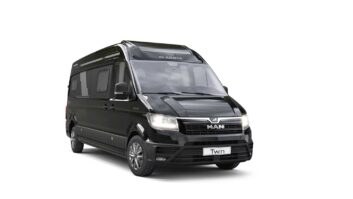
Adria Twin Max 680 SGX 2024
If your budget will stretch to it, the Adria Twin Max 680 SGX is a capacious...

Bailey Alora 69-4T 2024
Thoughtful design gives the Bailey Alora 69-4T, a compact three-berth, a distinctly Continental style, says Peter...
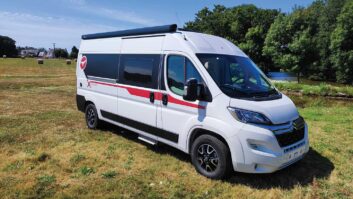
Pilote Vega V600G X Edition 2024
Small but perfectly formed, the Pilote Vega V600G X Edition is ideal for motorhomers who like...

Itineo Cozi PS700 2024
Thoughtful design makes the Itineo Cozi PS700, a comfortable and family-friendly budget six-berth, says Peter Baber

Vantage Luna 2024
The Vantage Luna is a dependable, comfortable campervan from the Leeds converter and it ticks all...

Le Voyageur Eterna 7.0 GJF 2024
If your budget will stretch to it, this lighter-weight four-berth from the premium French brand offers...
Choose Mobilvetta...The Ultimate...

The multi award-winning Mobilvetta Tekno-Line is the ultimate in motorhome luxury featuring two unique and versatile ranges - the K.Yacht A Class and Kea Coachbuilt.
Inside each Tekno Line motorhome Mobilvetta’s expert designers have created the perfect fusion of traditional hand-crafted style furniture and contemporary Italian design.
The /Auto series offers all models with a fully Automatic 180bhp engine on a 4400kg chassis. All K.Yacht and Kea models are 4 berth with 4 travelling seats and offer a fantastic payload for all your holiday essentials.
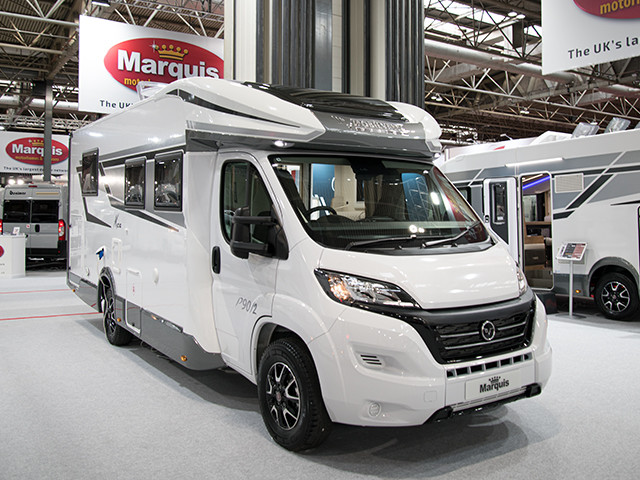
We have an exciting new addition for 2024 in the form of the /2 series. The /2 Series offers each popular layout currently available in both the K.Yacht and Kea ranges in a 140bhp manual 2 berth variation with optional beds, 2 travelling seats and a MTPLM weight of 3500kg to be driven by anyone holding a full UK driving licence with ease and regardless of their age.
Visit the Marquis Stand 8.25 in hall 8 to view models from this luxury range and take advantage of a great show deal! Click here to make a show appointment today!

With EVERY Mobilvetta K.Yacht and Kea Automatic Series purchased during the show!
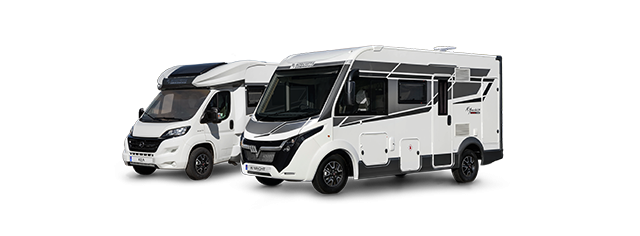
OFFER ENDS 22/10/23. Up to 66.9kg less Payload - Please ask for details.

With EVERY Mobilvetta K.Yacht and Kea /2 Series purchased during the show!
Introducing the all new /2 Series featuring all luxury K-Yacht & Kea models on a lighter 3500kg chassis with 2 travelling seats and optional beds!

OFFER ENDS 22/10/23. Up to 5kg less payload - ask for details.

With every New Mobilvetta K.Yacht and Kea Motorhome
Terms & Conditions Apply - click here for details.
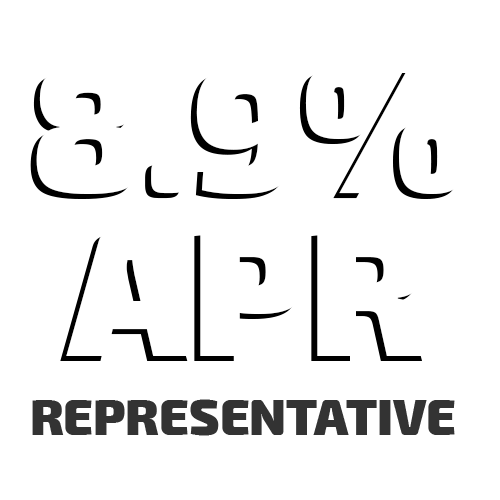
With ALL NEW Motorhomes purchased from 17th - 22nd October 2023
Finance your new mobilvetta motorhome from marquis at a special rate of 8.9% for a limited time only. this rate is applicable to new motorhomes only purchased from the 17th-22nd october 2023 - so be sure to secure a great leisure loan this october..
Terms & Conditions apply. Offer ends 22/10/23

Terms and Conditions
**Included in the final monthly repayment. Please see below for full T&Cs.
Finance is available to UK residents aged 18 years or over, subject to status. Maximum term 10 years on Hire Purchase. A deposit may be required.
This example does not constitute an offer of credit. Finance is subject to status. Terms and conditions apply. The actual documentation and/or other fees and charges that may apply may vary from time to time and from lender to lender.
Registered Office Marquis Leisure | Part of the Auto-Sleepers Group Ltd | Orchard Works | Willersey | Nr Broadway | Worcestershire | WR12 7QF | FCA Registered Number 308204
Auto-Sleepers Group Ltd T/A Marquis Motorhomes and Caravans is registered with the Financial Conduct Authority as a credit broker (No, 308204)
Marquis are a credit broker/intermediary and can introduce you to a limited number of lenders who provide funding. We will receive commission or other benefits for introducing you to such lenders. Finance available to UK residents aged 18 or over subject to application and status. Auto-Sleeper Group is regulated by the FCA with Limited permissions to conduct certain credit related activity. FCA Registered Number 308204.
Consumer Mission Statement
Initial Disclosure Document

K-YACHT Tekno Line MH-89
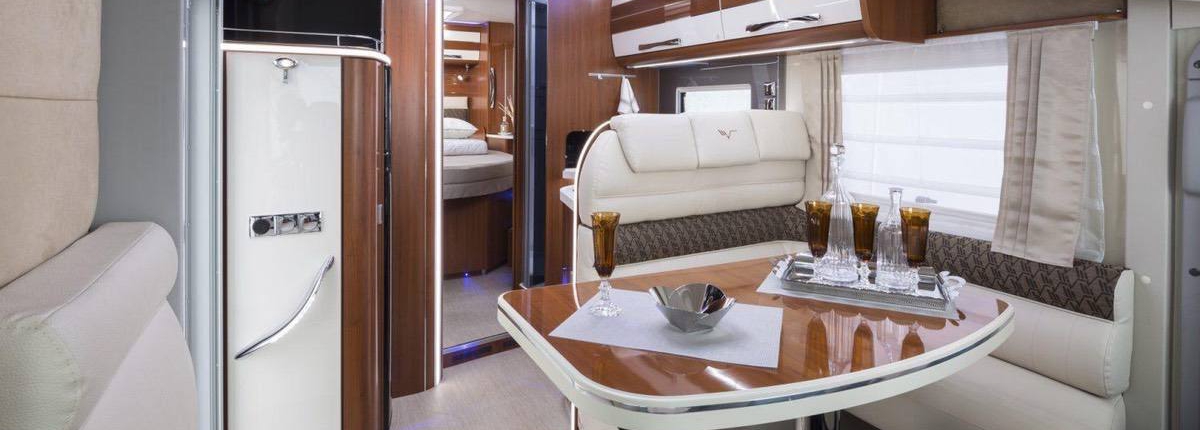
K-YACHT Tekno Line MH-89 2018
Europa € 71.557,- // nederland € 83.817,- // afleverklaar.
Genoemde prijzen zijn Aflever-Klaar dus inclusief; Afleverklaar maken, Transport, Fabrieksgarantie, COC / CvO document en 21% BTW . Europese prijs is exclusief de Nederlandse Belasting op Personenauto’s en Motorrijtuigen (BPM). Deze camper met Nederlands kenteken kent een meerprijs van € 12.260,- aan BPM. Wij verkopen en leveren in geheel Europa zonder BPM, dit is nu eventueel ook voor Nederland mogelijk. Benieuwd hoe? Kom naar onze showroom!
LENGTE 7.43 m
Queensbed (elektrisch in hoogte verstelbaar), 4 slaapplaatsen, 4 zitplaatsen, max. 3500 kg (standaard rijbewijs), rijklaar 3157 kg, laadvermogen 343 kg.
- Climate Control (automatische airco)
- Aluminium Velgen 16 Inch
- Lounge Trim level dashboard
- High Level instrumenten
- Leder bekleed stuurwiel en versnellingshendel
- Cabine blindering plisse
- Bekleed paneel dinette
- Werkbladen in Acrylsteen
- Vloerverwarming
- Safety Pack: Traction+, ESP, Cruise Control, Hill Holder-/ Descent
Fiat Ducato X290 35 Light, Motor 2.3l 130 pk / 96 kw Euro 6, 6 versnellingen, Elektrische ramen, Elektrisch verstelbare- en verwarmde buitenspiegels, Radiovoorbereiding inclusief speakers en antenne, Bumper voorzijde in wit, Wieldoppen, Airbags bestuurder en bijrijder, ASR (Anti Slip Regeling, Tractiecontrole), ABS (Anti Blokkeer Systeem), Stuurbekrachtiging, Centrale deurvergrendeling, 3-punts gordels.
Zitten // Slapen
4 Slaapplaatsen, 4 Zitplaatsen, Draaibare cabinestoelen, Cabinestoelen met armleuningen, Bedden met lattenbodems, Matrassen van hoge kwaliteit, Queens-bed met traploze elektrische hoogteverstelling, Hefbed boven dinette met traploze elektrische hoogteverstelling (half-integraal), Hefbed boven cabine (K-Yacht), Bed-ombouw naar Kingsize-bed bij indelingen met 2 aparte bedden
Winter pakket (Watertanks vorstvrij en geïsoleerd), Drink-watertank 120 liter, Afval-watertank 110 liter, Koelkast 150 liter met groot vriesvak, Afzuigkap, Gasbakoven, Combi 6 verwarming Truma, CP plus paneel Truma, Douchevlonder, TV aansluiting 12- en 230v, TV beugel uittrek-/ draaibaar, Night Blue veiligheidsverlichting voor de nacht, Hordeur bij entree, Entreedeur met raam, blindering en afvalbakje, Entreedeur met dubbele vergrendeling en centrale vergrendeling, Voorbereiding achteruitrijcamera, Verlichting in garageruimte, Opbergruimte in zijskirts, Voorbereiding airconditioning woongedeelte, Douche buitenzijde, Anti-condens systeem (beluchting systeem bovenkastjes), Drukwaterpomp Shurflo, Grote garage met 2 deuren, LED verlichting, iTech 4.0 (Houtvrije opbouw, wanden, dak en bodem opgebouwd uit GFK/Styrofoam/Kunststof laminaat), Afleverklaar maken, Transport, Fabrieksgarantie, COC/CvO, Technische keuring
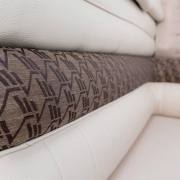
Bekijk alle bekledingen ->
- " class="vfb-submit" />
DEALER ZUID:
Dealer noord:, interessante links:, meer weten vraag het ons.
- Wat kunnen we voor u doen? Offerte met Nederlands kenteken (inclusief BPM) Offerte Export (exclusief BPM) Afspraak bezoek showroom Antwoord op vraag Brochure verzenden
Verificatie tegen spam:
- Dit vak is voor spambescherming - laat het leeg
Deze website maakt gebruik van cookies voor interne analysedoeleinden en voor het goed laten functioneren van de website. Door op deze website te blijven en verder te surfen gaat u akkoord met het plaatsen van de benodigde cookies en helpt u ons het gebruikersgemak van onze website te kunnen verbeteren. Dank u wel!
Cookie en privacy instellingen
We kunnen vragen om cookies op uw apparaat te plaatsen. We gebruiken cookies om ons te laten weten wanneer u onze websites bezoekt, hoe u met ons omgaat, om uw gebruikerservaring te verrijken en om uw relatie met onze website aan te passen.
Klik op de verschillende rubrieken voor meer informatie. U kunt ook enkele van uw voorkeuren wijzigen. Houd er rekening mee dat het blokkeren van sommige soorten cookies van invloed kan zijn op uw ervaring op onze websites en de services die we kunnen bieden.
Deze cookies zijn strikt noodzakelijk om u diensten aan te bieden die beschikbaar zijn via onze website en om sommige functies ervan te gebruiken.
Omdat deze cookies strikt noodzakelijk zijn om de website te leveren, heeft het weigeren ervan invloed op het functioneren van onze site. U kunt cookies altijd blokkeren of verwijderen door uw browserinstellingen te wijzigen en alle cookies op deze website geforceerd te blokkeren. Maar dit zal u altijd vragen om cookies te accepteren/weigeren wanneer u onze site opnieuw bezoekt.
We respecteren volledig als u cookies wilt weigeren, maar om te voorkomen dat we u telkens opnieuw vragen vriendelijk toe te staan om een cookie daarvoor op te slaan. U bent altijd vrij om u af te melden of voor andere cookies om een betere ervaring te krijgen. Als u cookies weigert, zullen we alle ingestelde cookies in ons domein verwijderen.
We bieden u een lijst met opgeslagen cookies op uw computer in ons domein, zodat u kunt controleren wat we hebben opgeslagen. Om veiligheidsredenen kunnen we geen cookies van andere domeinen tonen of wijzigen. U kunt deze controleren in de beveiligingsinstellingen van uw browser.
Deze cookies verzamelen informatie die in geaggregeerde vorm wordt gebruikt om ons te helpen begrijpen hoe onze website wordt gebruikt of hoe effectief onze marketingcampagnes zijn, of om ons te helpen onze website en applicatie voor u aan te passen om uw ervaring te verbeteren.
Als u niet wilt dat wij uw bezoek aan onze site volgen, kunt u dit in uw browser hier uitschakelen:
We gebruiken ook verschillende externe services zoals Google Webfonts, Google Maps en externe videoproviders. Aangezien deze providers persoonlijke gegevens zoals uw IP-adres kunnen verzamelen, kunt u ze hier blokkeren. Houd er rekening mee dat dit de functionaliteit en het uiterlijk van onze site aanzienlijk kan verminderen. Wijzigingen zijn pas effectief zodra u de pagina herlaadt
Google Webfont Instellingen:
Google Maps Instellingen:
Google reCaptcha instellingen:
Vimeo en Youtube video's insluiten:
De volgende cookies zijn ook nodig - U kunt kiezen of u ze wilt toestaan:
- Bahasa Indonesia
- Slovenščina
- Science & Tech
- Russian Kitchen
Cruising the Moskva River: A short guide to boat trips in Russia’s capital

There’s hardly a better way to absorb Moscow’s atmosphere than on a ship sailing up and down the Moskva River. While complicated ticketing, loud music and chilling winds might dampen the anticipated fun, this checklist will help you to enjoy the scenic views and not fall into common tourist traps.
How to find the right boat?
There are plenty of boats and selecting the right one might be challenging. The size of the boat should be your main criteria.
Plenty of small boats cruise the Moskva River, and the most vivid one is this yellow Lay’s-branded boat. Everyone who has ever visited Moscow probably has seen it.

This option might leave a passenger disembarking partially deaf as the merciless Russian pop music blasts onboard. A free spirit, however, will find partying on such a vessel to be an unforgettable and authentic experience that’s almost a metaphor for life in modern Russia: too loud, and sometimes too welcoming. Tickets start at $13 (800 rubles) per person.
Bigger boats offer smoother sailing and tend to attract foreign visitors because of their distinct Soviet aura. Indeed, many of the older vessels must have seen better days. They are still afloat, however, and getting aboard is a unique ‘cultural’ experience. Sometimes the crew might offer lunch or dinner to passengers, but this option must be purchased with the ticket. Here is one such option offering dinner for $24 (1,490 rubles).

If you want to travel in style, consider Flotilla Radisson. These large, modern vessels are quite posh, with a cozy restaurant and an attentive crew at your service. Even though the selection of wines and food is modest, these vessels are still much better than other boats.

Surprisingly, the luxurious boats are priced rather modestly, and a single ticket goes for $17-$32 (1,100-2,000 rubles); also expect a reasonable restaurant bill on top.
How to buy tickets?
Women holding photos of ships promise huge discounts to “the young and beautiful,” and give personal invitations for river tours. They sound and look nice, but there’s a small catch: their ticket prices are usually more than those purchased online.
“We bought tickets from street hawkers for 900 rubles each, only to later discover that the other passengers bought their tickets twice as cheap!” wrote (in Russian) a disappointed Rostislav on a travel company website.
Nevertheless, buying from street hawkers has one considerable advantage: they personally escort you to the vessel so that you don’t waste time looking for the boat on your own.

Prices start at $13 (800 rubles) for one ride, and for an additional $6.5 (400 rubles) you can purchase an unlimited number of tours on the same boat on any given day.
Flotilla Radisson has official ticket offices at Gorky Park and Hotel Ukraine, but they’re often sold out.
Buying online is an option that might save some cash. Websites such as this offer considerable discounts for tickets sold online. On a busy Friday night an online purchase might be the only chance to get a ticket on a Flotilla Radisson boat.
This website (in Russian) offers multiple options for short river cruises in and around the city center, including offbeat options such as ‘disco cruises’ and ‘children cruises.’ This other website sells tickets online, but doesn’t have an English version. The interface is intuitive, however.
Buying tickets online has its bad points, however. The most common is confusing which pier you should go to and missing your river tour.

“I once bought tickets online to save with the discount that the website offered,” said Igor Shvarkin from Moscow. “The pier was initially marked as ‘Park Kultury,’ but when I arrived it wasn’t easy to find my boat because there were too many there. My guests had to walk a considerable distance before I finally found the vessel that accepted my tickets purchased online,” said the man.
There are two main boarding piers in the city center: Hotel Ukraine and Park Kultury . Always take note of your particular berth when buying tickets online.
Where to sit onboard?
Even on a warm day, the headwind might be chilly for passengers on deck. Make sure you have warm clothes, or that the crew has blankets ready upon request.
The glass-encased hold makes the tour much more comfortable, but not at the expense of having an enjoyable experience.

Getting off the boat requires preparation as well. Ideally, you should be able to disembark on any pier along the way. In reality, passengers never know where the boat’s captain will make the next stop. Street hawkers often tell passengers in advance where they’ll be able to disembark. If you buy tickets online then you’ll have to research it yourself.
There’s a chance that the captain won’t make any stops at all and will take you back to where the tour began, which is the case with Flotilla Radisson. The safest option is to automatically expect that you’ll return to the pier where you started.
If using any of Russia Beyond's content, partly or in full, always provide an active hyperlink to the original material.
to our newsletter!
Get the week's best stories straight to your inbox
- What to do in Moscow City, if you’re not mega-rich
- Moscow after dusk: 10 places to drink, dance, and groove
- 5 things you must do in Moscow in 2018 between football matches (or without them)
- Sandwiched between Moscow and St. Petersburg: How to spend a perfect weekend in Tver
- 24 or 48 hours in Moscow: Where to go and what to do in 2019
This website uses cookies. Click here to find out more.
Three decades after the Soviet era, this Moscow street echoes what was.
And hints where russia is heading., welcome to tverskaya street.
MOSCOW — Thirty years ago, the Soviet Union ceased to be. The flag was lowered for the last time on Dec. 25, 1991. That moment still raises deep questions for the U.S.S.R.’s heirs: “Who were we as Soviets, and where are we going as Russians?”
Many of the answers can be found on Moscow’s main thoroughfare — named Gorky Street, after writer Maxim Gorky, from 1932 to 1990, and renamed Tverskaya Street, a nod to the ancient city of Tver, as the Soviet Union was awash in last-gasp reforms.
It was the Soviet Union’s display window on the bright future that Kremlin-run communism was supposed to bring. It was where the KGB dined, the rich spent their rubles, Vladimir Lenin gave speeches from a balcony, and authorities wielded their power against one of the most famous Soviet dissidents, Alexander Solzhenitsyn.

In the 1990s, Tverskaya embodied the fast-money excesses of the post-Soviet free-for-all. In later years, it was packed with hopeful pro-democracy marchers. And now , under President Vladimir Putin, it is a symbol of his dreams of reviving Russia as a great power, reliving past glories and crushing any opposition to his rule.
Join a tour of Moscow’s famed Tverskaya Street.
Hotel National: Where the Soviet government began
The window in Room 107 at the Hotel National faces Red Square and the Kremlin. It offers a perfect view of Lenin’s tomb — fitting, since he was Room 107’s most famous guest.
The Kremlin was damaged during the Russian Revolution in 1917. So Lenin and his wife moved into Room 107 for seven days in March 1918, making the hotel the first home of the Soviet government.

The Hotel National in Moscow, from top: Artwork in the Socialist Realist style — which artists were ordered to adopt in the 1930s — still adorns the hotel; Elena Pozolotina has worked at the hotel since 1995; the hotel, which contains a restaurant, was built in 1902; the National has hosted notable guests, including Soviet leader Vladimir Lenin, then-Sen. Barack Obama (D-Ill.) and actor Jack Nicholson. (Photos by Arthur Bondar for The Washington Post)
The National, built in 1902 during the era of Imperial Russia, also accommodated other Soviet leaders, including Leon Trotsky and Felix Dzerzhinsky, chief of the secret police. The building continued to be used by the Soviet government as a hostel for official party delegates and was renamed First House of Soviets in 1919.
Guests can now stay in the same room Lenin did for about $1,300 a night. In more recent years, the hotel has hosted notable guests including Barack Obama (when he was a senator) and actor Jack Nicholson.
“This hotel feels a little like a museum,” said Elena Pozolotina, who has worked at the National since 1995.
“We have rooms that look onto Tverskaya Street, and we always explain to guests that this is the main street of our city,” Pozolotina said. “This corner of Tverskaya that we occupy, it’s priceless.”
Stalin’s plan: ‘The building is moving’
When Soviet leader Joseph Stalin demanded a massive redevelopment of Moscow in 1935, an order came to transform modest Gorky Street into a wide, awe-inspiring boulevard.
Engineer Emmanuel Gendel had the job of moving massive buildings to make way for others. Churches and monasteries were blown up, replaced by newspaper offices and a huge cinema.
The Moscow Central Eye Hospital was sheared from its foundation, rotated 97 degrees, jacked up, hitched on rails and pushed back 20 yards — with surgeons operating all the while, or so official media reported at the time.

Gendel’s daughter, then about 8, proudly stood at a microphone, announcing: “Attention, attention, the building is moving.” Tatiana Yastrzhembskaya, Gendel’s granddaughter and president of the Winter Ball charity foundation in Moscow, recalls that Gendel extolled communism but also enjoyed the rewards of the elite. He drove a fine car and always brought the family the best cakes and candies, she said.
The largest Gorky Street building Gendel moved was the Savvinskoye Courtyard. The most difficult was the Mossoviet, or Moscow city hall, with a balcony where Lenin had given speeches. The building, the former residence of the Moscow governor general, had to be moved with its basement. The ground floor had been a ballroom without central structural supports.

Moving buildings on Gorky Street in 1940, from left: A mechanic at a control panel regulates the supply of electricity while a house is being moved; a postal worker passes a moving house; a specialist unwinds a telephone cable during a building move to maintain uninterrupted communication; 13 rail tracks were placed under a house, on which 1,200 metal rollers were laid. (Photos by RGAKFD)
Gendel’s skills were used all over the U.S.S.R. — straightening towers on ancient mosques in Uzbekistan, inventing a means to drag tanks from rivers during World War II and consulting on the Moscow Metro.
Like many of the Soviet Union’s brightest talents, Gendel found that his freedom was tenuous. His ex-wife was called by the KGB internal spy agency in 1937 and asked to denounce him. She refused, and he avoided arrest.

“I believe he was not arrested and sent to the camps because he was a unique expert,” said Yastrzhembskaya. World War II, known in Russia as the Great Patriotic War, interrupted the Master Plan for Gorky Street.
Aragvi restaurant: A haunt of the KGB
In the 1930s, the head of the elite NKVD secret police, Lavrenty Beria, one of the architects of the Stalin-era purges, ordered the construction of a state-owned restaurant, Aragvi, to showcase food from his home republic of Georgia.
One night, NKVD agents descended in several black cars on a humble Georgian canteen in Moscow that Beria had once visited. The agents ordered the chef, Longinoz Stazhadze, to come with them. The feared NKVD was a precursor to the KGB.
Stazhadze thought he was being arrested, his son Levan told Russian media. He was taken to Beria, who said that he had agreed with “the Boss” (Stalin) that Stazhadze would run Aragvi. Stazhadze had grown up a peasant, sent to work in a prince’s kitchens as a boy.

Aragvi opened in 1938. It was only for the gilded set, a reminder that the “Soviet paradise” was anything but equitable. The prices were astronomical. It was impossible to get a table unless the doorman knew you or you could pay a hefty bribe.
Aragvi, at No. 6 Tverskaya, was a favorite of the secret police; government officials; cosmonauts and pilots; stars of theater, movies and ballet; directors; poets; chess masters. Beria reputedly dined in a private room. Poet Sergei Mikhalkov said he composed the lyrics of the Soviet national anthem while sitting in the restaurant in 1943.
It was privatized in the 1990s and struggled, before closing in 2002. It reopened in 2016 after a $20 million renovation. But the new Aragvi closed abruptly in 2019 amid reports of a conflict between its owner and the building managers.
“You put your entire soul into cooking,” said the former head chef, Nugzar Nebieridze, 59, celebrated for his khinkali, a meaty dumpling almost the size of a tennis ball. He was devastated to find himself unemployed. But other doors opened. He now prefers to travel, giving master classes around Russia.
Stalin’s funeral: A deadly street crush that never officially happened
On March 6, 1953, the day after Stalin died of a stroke, an estimated 2 million Muscovites poured onto the streets. They hoped to catch a glimpse of his body, covered with flowers and laid out in the marbled Hall of Columns near Red Square.
Yulia Revazova, then 13, sneaked from her house with her cousin Valery without telling their parents. As they walked toward Pushkin Square, at one end of Gorky Street, the procession turned into a scene of horror. They saw people falling and being trampled. Some were crushed against metal fences. Valery, who was a few years older, grabbed Yulia by the hand and dragged her out of the crowd.

“He held my hand really tight and never let it go, because it was pure madness,” she recalled recently. “It took us four or five hours to get out of there. People kept coming and coming. I couldn’t even call it a column; it was just an uncontrollable mass of people.”
“I still have this feeling, the fear of massive crowds,” added Revazova, 82. “To this day, if I see a huge group of people or a really long line, I just cross the street.”
Neither Revazova nor her cousin knew about Stalin’s repressions.
“People were crying. I saw many women holding little handkerchiefs, wiping away tears and wailing,” she recalled. “That’s the psychology of a Soviet person. If there is no overarching figure above, be it God or Lenin, life will come crashing down. The era was over, and there was fear. What will we do without Stalin?”
Officials never revealed how many people died that day. The Soviet-approved archival footage of the four days of national mourning showed only orderly marches and memorials.
No. 9: The ruthless culture minister
The Soviet culture minister, the steely Yekaterina Furtseva, was nicknamed Catherine the Third, after the forceful Russian Empress Catherine the Great. Furtseva destroyed writers, artists or anyone else who challenged Soviet ideas. She lived at an elite 1949 apartment building for government officials at No. 9 — an ultra-prestigious address with a view of the Kremlin.
Furtseva, a former small-town weaver, made sure that No. 9 was only for the cream of party officials and other notables, such as famous Soviet actress Natalia Seleznyova, scientists, conductors and architects.
Riding the coattails of Soviet leader Nikita Khrushchev, Furtseva was the only woman in the Politburo and later became the Soviet Union’s cultural gatekeeper despite her provincial sensibilities. She once infamously mixed up a symphony with an opera, and critics were quick to notice.

“She had little in common with the artistic leaders of her country except a liking for vodka,” Norwegian painter Victor Sparre wrote in his 1979 book on the repression of dissident Soviet writers, “The Flame in the Darkness.”
Furtseva was famous for previewing performances and declaring anyone even subtly critical of Soviet policies as being anti-state. Director Yuri Lyubimov described one such visit to Moscow’s Taganka Theater in 1969, when she turned up wearing diamond rings and an astrakhan coat. She banned the play “Alive,” depicting a cunning peasant’s struggle against the collective farm system. She “was livid, she kept shouting,” he told L’Alternative magazine in 1984. She stormed out, warning him she would use her influence, “up to the highest levels,” against him.
He was expelled from the party and in 1984 was stripped of his citizenship. She vehemently denounced Solzhenitsyn, and banned the Bolshoi Ballet’s version of “Carmen” in 1967 over prima ballerina Maya Plisetskaya’s sensual performance and “un-Soviet” costumes that did not cover enough leg.
“The ballet is all erotica,” she told the dancer. “It’s alien to us.” But Plisetskaya, whom Khrushchev once called the world’s best dancer, fought back. The ballet went on with some excisions (the costumes stayed) and became a legend in the theater’s repertoire.
Furtseva was nearly felled by scandal in 1974, ordered to repay $80,000 spent building a luxurious dacha, or country home, using state labor. She died months later.

Where Solzhenitsyn was arrested
The Nobel Prize-winning Solzhenitsyn exposed the Soviet system’s cruelty against some of its brightest minds, trapped in the gulag, or prison camps.
Solzhenitsyn was given eight years of hard labor in 1945 for privately criticizing Stalin, then three years of exile in Kazakhstan, a Soviet republic at the time. His books were banned. After release from exile in 1956, he was allowed to make only 72-hour visits to the home of his second wife, Natalia, at 12 Gorky St., Apt. 169. Solzhenitsyn had to live outside the city.
“People knew that there were camps, but not many people, if any, knew what life was like in those camps. And he described it from the inside. He had been there himself, and that was shocking to a lot of people,” said Natalia Solzhenitsyna during a recent interview at the apartment, which became a museum in 2018.
“Many people say that he did make a contribution to the final fall of the Soviet Union.”
Solzhenitsyn, who died in 2008, called Russia “the land of smothered opportunities.” He wrote that it is always possible to live with integrity. Lies and evil might flourish — “but not through me.”
The museum displays tiny handwritten copies of Solzhenitsyn’s books, circulated secretly; film negatives of letters smuggled to the West; and beads made of compacted bread that he used to memorize poems in prison.
“He spent a lot of time here with his children. We were always very busy. And we just enjoyed ourselves — being together,” Solzhenitsyna said. They had three sons.

No. 12 Gorky St., from top: Natalia Solzhenitsyna lived in the apartment for years, and her husband, Soviet dissident Alexander Solzhenitsyn, was allowed only short visits; the site now houses a museum displaying items connected to him, such as negatives containing a copy of a novel he wrote; another exhibit includes Solzhenitsyn’s clothes from when he was sent to the gulag and beads made of compacted bread that he used to memorize poems; the Nobel Prize-winning writer’s desk is featured at the museum. (Photos by Arthur Bondar for The Washington Post)
Because of KGB bugs, if the couple were discussing something sensitive, they wrote notes to each other, and then destroyed them. Two KGB agents usually roosted in the stairwell on the floor above, with two more on the floor below.
“The Soviet authorities were afraid of him because of his popularity among intellectuals, writers, people of culture and the intelligentsia.”
Her favorite room is decked with black-and-white photos of dissidents sent to the gulag, the Soviet Union’s sprawling system of forced labor camps. “It’s dedicated to the invisibles,” she said, pointing out friends.
Sweden planned to award Solzhenitsyn’s 1970 literature prize in the Gorky Street apartment, but the writer rejected a secret ceremony. A Swedish journalist in Moscow, Stig Fredrikson, was Solzhenitsyn’s smuggler. He carried Solzhenitsyn’s Nobel lecture on tightly rolled film disguised as a battery in a transistor radio, and he took other letters to the West and transported photos taped to his back.
“I felt that there was a sense of unfairness that he was so isolated and so persecuted,” Fredrikson said in a recent interview. “I got more and more scared and more and more afraid every time I met him.”
In 1971, the Soviet Union allegedly tried to poison Solzhenitsyn using a secret nerve agent, leaving him seriously ill. Early 1974 was tense. The prosecutor subpoenaed him. State newspapers railed against him.
The morning of Feb. 12, 1974, the couple worked in their study. In the afternoon, he walked his 5-month-old son, Stepan, in the yard below.
“He came back here, and literally a minute later, there was a ring at the door. There were eight men. They immediately broke the chain and got in,” his widow said. “There was a prosecutor in his prosecutor’s uniform, two men in plainclothes, and the rest were in military uniform. They told him to get dressed.”
“We hugged and we kept hugging for quite a while,” she recalled. “The last thing he told me was to take care of the children.”
He was deported to West Germany. The couple later settled in Vermont and set up a fund to help dissident writers, using royalties from his book “The Gulag Archipelago.” About 1,000 people still receive money from the fund, according to Solzhenitsyna.
When the writer and his wife returned to Russia in 1994, they traveled across the country by train. Thousands of people crushed into halls to hear him speak.
Solzhenitsyn abhorred the shock therapy and unchecked capitalism of the 1990s and preferred Putin’s tough nationalism. He died of heart failure at 89 in August 2008, five months after a presidential election in which Putin switched places with the prime minister, Dmitry Medvedev, in a move that critics saw as a ploy to get around constitutional term limits.
No. 6: ‘Feasts of thought’
Behind a grand Stalin-era apartment block at 6 Gorky St. sits an ornate 1907 building famous for its facade, art nouveau glazed blue tiles, elegant arches and baroque spires. Once a monastery dormitory, it was a staple of pre-Soviet postcards from Moscow. But in November 1939, the 26,000-ton building was put on rails and pushed back to widen the street.
Linguists Lev and Raisa Kopelev lived in Apt. 201 on the top floor. Their spacious dining room became a favored haven for Moscow’s intelligentsia from the 1950s to the 1980s.

“People gathered all the time — to talk. In this apartment, like many other kitchens and dining rooms, at tables filled more often than not with vodka, herring and vinaigrette salad, feasts of thought took place,” said Svetlana Ivanova, Raisa’s daughter from another marriage, who lived in the apartment for nearly four decades.
Solzhenitsyn and fellow dissident Joseph Brodsky were Kopelev family friends, as were many other artists, poets, writers and scientists who formed the backbone of the Soviet human rights movement of the 1960s.
As a writer and dissident, Kopelev had turned his back on the Communist Party and a prestigious university position. The onetime gulag prisoner inspired the character Lev Rubin in Solzhenitsyn’s novel “In the First Circle,” depicting the fate of arrested scientists.
“The apartment was a special place for everyone. People there were not afraid to speak their mind on topics that would be considered otherwise risky,” Ivanova said. “A new, different spirit ruled in its walls.”
Eliseevsky: Pineapples during a famine
The Eliseevsky store at No. 16 was a landmark for 120 years — born in czarist Russia, a witness to the rise and fall of the Soviet Union, a survivor of wars, and a bastion during eras of shortages and plenty. It closed its doors in April.
Eliseevsky fell on hard times during the coronavirus pandemic, as international tourists dwindled and Russians sought cheaper grocery-shopping alternatives.
In the palace-like interior, two chandeliers hang from an ornate ceiling. Gilt columns line the walls. The front of the store, looking out at Tverskaya Street, has a row of stained glass.

The Eliseevsky store, which opened in 1901, is seen in April, with a few customers and some archival photos, as it prepared to close as an economic victim of the coronavirus pandemic. (Photos by Arthur Bondar for The Washington Post)
Denis Romodin, a historian at the Museum of Moscow, said Eliseevsky is one of only two retail spaces in Moscow with such pre-revolutionary interiors. But Eliseevsky’s level of preservation made it “one of a kind,” he said.
The building was once owned by Zinaida Volkonskaya, a princess and Russian cultural figure in the 19th century. She remodeled the house into a literary salon whose luminaries included Russia’s greatest poet, Alexander Pushkin.
St. Petersburg merchant Grigory Eliseev opened the market in 1901. It quickly became a hit among Russian nobility for its selection of European wines and cheeses.

Romodin said it was Russia’s first store with price tags. Before Eliseevsky, haggling was the norm. And it was also unique in having innovative technology for the time: electric-powered refrigerators and display cases that allowed goods to be stored longer.
Even in the Soviet Union’s hungriest years, the 1930s famine, Eliseevsky stocked pineapples.
“One could find outlandish delicacies here, which at that time seemed very exotic,” Romodin said. “It was already impossible to surprise Muscovites with wine shops. But a grocery store with luxurious interiors, and large for that time, amazed and delighted Muscovites.”

The First Gallery: A glimpse of openness
In 1989, in a dusty government office by a corner of Pushkin Square, three young artists threw off decades of suffocating state control and opened the Soviet Union’s first independent art gallery.
That April, Yevgeny Mitta and two fellow students, Aidan Salakhova and Alexander Yakut, opened First Gallery. At the time, the Soviet Union was opening up under policies including glasnost, which gave more room for public debate and criticism.
Artists were ordered to adopt the Socialist Realist style in 1934, depicting scenes such as happy collective farmworkers. Expressionist, abstract and avant-garde art was banned. From the 1970s, underground art exhibitions were the only outlets to break the Soviet-imposed rules.

The First Gallery, from top: Yevgeny Mitta, Aidan Salakhova and Alexander Yakut opened the Soviet Union’s first independent art gallery in 1989 and received media attention; Mitta works on a painting that he displayed at his gallery; Mitta recalled recently that he “felt we had to make something new”; an undated photo of Mitta at his gallery in Soviet times. (Photos by Arthur Bondar for The Washington Post and courtesy of Yevgeny Mitta)
“I just felt we had to make something new,” recalled Mitta, 58, who kept his interest in contemporary expressionism a secret at a top Moscow art school in the 1980s.
“It was like nothing really happened in art history in the 20th century, like it stopped,” he said. “The Socialist Realism doctrine was invented and spread to the artists as the only one, possible way of developing paintings, films and literature.”
After the collapse of the Soviet Union, artists had to “learn how to survive, what to do, how to work and make a living,” he said.
McDonald’s: ‘We were not used to smiling’
In the Soviet Union’s final years, a mania raged for all things Western. Estée Lauder opened the first Western-brand shop on Gorky Street in 1989, after meeting Raisa Gorbachev, the wife of reformist Soviet leader Mikhail Gorbachev, in December 1988.
The Soviet Union’s first McDonald’s, located across Pushkin Square on Gorky Street, opened on Jan. 31, 1990 — a yellow-arched symbol of Gorbachev’s perestroika economic reforms. Pizza Hut opened later that year. (In 1998, Gorbachev starred in a commercial for the pizza chain.)
Karina Pogosova and Anna Patrunina were cashiers at the McDonald’s on opening day. The line stretched several blocks. Police officers stood watch to keep it organized.

The Soviet Union’s first McDonald’s opened in 1990 and eager customers lined up to enter; Karina Pogosova, left, and Anna Patrunina were cashiers at the fast-food restaurant on Gorky Street then, and they are senior executives with the company today. (Photos by Peter Turnley/Corbis/VCG/Getty Images and Arthur Bondar for The Washington Post)
“The atmosphere was wonderful. The first day I had to smile the entire day and my face muscles hurt,” Patrunina said. “This is not a joke. Russians do not smile in general, so we were not used to smiling at all, not to mention for more than eight hours straight.”
Pogosova and Patrunina were students at the Moscow Aviation Institute when they learned McDonald’s was hiring through an ad in a Moscow newspaper. Interview questions included: “How fast can you run 100 meters?” It was to gauge if someone was energetic enough for the job.
Pogosova and Patrunina are still with the company today, as senior vice president of development and franchising and vice president of operations, respectively.
“I thought that this is the world of opportunities and this new world is coming to our country, so I must be in this new world,” Patrunina said.
The smiling staff wasn’t the only culture shock for customers. Some had never tried the fountain sodas that were available. They were unaccustomed to food that wasn’t eaten with utensils. The colorful paper boxes that Big Macs came in were occasionally saved as souvenirs.
McDonald’s quickly became a landmark on the street.
“I remember very well that the street and the entire city was very dark and McDonald’s was like an island of light with bright signage,” Pogosova said. “The street started to change after McDonald’s opened its first restaurant there.”
Wild ’90s and a missing ballerina
The end of the Soviet Union uncorked Moscow’s wild 1990s. Some people made instant fortunes by acquiring state-owned enterprises at throwaway prices. Rules were being written on the fly. The city was pulsing with possibilities for those with money or those desperate to get some.
“It was easy to get drunk on this,” said Alex Shifrin, a former Saatchi & Saatchi advertising executive from Canada who lived in Moscow from the mid-1990s until the late 2000s.
It all was on full display at Night Flight, Moscow’s first nightclub, opened by Swedish managers in 1991, in the final months of the Soviet Union, at Tverskaya 17. The club introduced Moscow’s nouveau elite to “face control” — who merits getting past the rope line — and music-throbbing decadence.
The phrase “standing on Tverskaya” made its way into Russian vernacular as the street became a hot spot for prostitutes. Toward the end of the 2000s, Night Flight had lost its luster. The club scene in Moscow had moved on to bigger and bolder venues.
Decades before, No. 17 had been famous as the building with the dancer: a statue of a ballerina, holding a hammer and sickle, placed atop the cupola during Stalin’s building blitz.

Muscovites nicknamed the building the House Under the Skirt.
“The idea was to have Gorky Street as a museum of Soviet art. The statues represented a dance of socialism,” art historian Pavel Gnilorybov said. “The ballerina was a symbol of the freedom of women and the idea that, before the revolution, women were slaves. It is as if she is singing an ode to the regime.”
The crumbling statues were removed by 1958. People forgot them. Now a group of Muscovites, including Gnilorybov, are campaigning for the return of the ballerina.
“It’s an idea that we want to give the city as a gift. It’s not political,” he said. “It’s beautiful.”
Pushkin Square: For lovers and protesters
Pushkin Square has been Moscow’s favorite meeting place for friends, lovers and political demonstrations.
In November 1927, Trotskyist opponents of Stalin marched to the 27th House of Soviets at one end of Tverskaya Street, opposite the Hotel National, in one of the last public protests against the Soviet ruler.

In December 1965, several dozen dissidents gathered in Pushkin Square to protest the trials of two writers. It became an annual event. People would gather just before 6 p.m. and, on the hour, remove their hats for a minute.
In 1987, dissidents collected signatures at Pushkin Square and other locations calling for a memorial to those imprisoned or killed by the Soviet state. The movement evolved into Memorial, a leading human rights group. Memorial was declared a “foreign agent” in 2016 under Putin’s sweeping political crackdowns.

In January 2018, left, and January 2021, right, protesters gathered at Pushkin Square. (Photos by Arthur Bondar for The Washington Post)
Protests in support of opposition leader Alexei Navalny were held at Pushkin Square earlier this year. And it is where communists and liberals rallied on a rainy September night to protest 2021 parliamentary election results that gave a landslide win to Putin’s United Russia party despite widespread claims of fraud.
Nearly 30 years after the fall of the U.S.S.R., Putin’s Russia carries some echoes of the stories lived out in Soviet times — censorship and repressions are returning. Navalny was poisoned by a nerve agent in 2020 and later jailed. Many opposition figures and independent journalists have fled the country. The hope, sleaze and exhilaration of the 1990s have faded. Tverskaya Street has settled into calm stagnation, waiting for the next chapter.
Arthur Bondar contributed to this report.
Correction: A map accompanying this article incorrectly spelled the first name of a former Soviet leader. He is Vladimir Lenin, not Vladmir Lenin. The map has been corrected.
About this story
Story editing by Robyn Dixon and Brian Murphy. Photos and videos by Arthur Bondar. Archival footage from the Russian State Documentary Film and Photo Archive at Krasnogorsk; footage of Joseph Stalin’s funeral from the Martin Manhoff Archive, courtesy of Douglas Smith. Photo editing by Chloe Coleman. Video editing by Jason Aldag. Design and development by Yutao Chen. Design editing by Suzette Moyer. Maps by Dylan Moriarty. Graphics editing by Lauren Tierney. Copy editing by Melissa Ngo.
- Yekaterinburg
- Novosibirsk
- Vladivostok

- Top Sights in Moscow
- Tours to Russia
- Practicalities
- Russia in Lists
Rusmania • Deep into Russia
Sights in Khamovniki District
Moscow’s central district of Khamovniki is situated directly south-west of the centre and south of the Arbat District within a curve of the River Moskva. Its is considered a rather elite district of Moscow. Its main streets are Ulitsa Volkhonka which branches off into Ulitsa Preschistenka and Ulitsa Ostozhenka. After the Garden Ring, which is made up here by Zubovsky Bulvar and Krimsky Bridge, the two streets become Ulitsa Bolshaya Pirogovskaya and Komsomolsky Prospekt respectively. The very tip of Khamovniki is located beyond the Third Ring Road and is occupied by the Luzhniki Olympic Complex. The district is served by Kropotkinskaya to Vorobyovy Gory metro stations on the red line.
Around Frunzenskaya Metro

Ivan Sechenov First Moscow State Medical University
- 2 Ulitsa Bolshaya Pirogovskaya
- Park Kultury, Frunzenskaya
- http://www.mma.ru/science/museum/ (Museum)
- 10:00 - 17:00. Closed on weekends, public holidays and the first Monday of the month (Museum)
Immediately behind Archangel Michael's Church among the Clinics are the clinics themselves - the Ivan Sechenov First Moscow State Medical University, which was founded in 1758 as the medical faculty of the Moscow State University. Running all along the University's premises are several statues of leading Russian doctors: gynaecologist Vladimir Snegirev, paediatrician Nil Filatov (on the corner of Skver Devichievo Polya), field-surgeon Nikolai Pirogov and physiologist Ivan Sechenov;… Read more »
Pavel Korin House-Museum
- 6c2 Ulitsa Malaya Pirogovskaya
- Frunzenskaya, Sportivnaya
- http://www.tretyakovgallery.ru
- Currently closed for renovation (as of August 2013)
In a court yard off Ulitsa Malaya Pirogovskaya, which runs parallel below Ulitsa Bolshaya Pirogovskaya, is the former home and workshop of the artist Pavel Korin, which in 1968 was turned into the Pavel Korin House-Museum. The museum displays the work of the artist who is most known for his unfinished giant painting called 'Farewell to Rus' depicting the last service of Patriarch Tikhon in the Dormition Cathedral in the Kremlin. The museum is run as a branch of the State Tretyakov… Read more »

Pogodin's Izba
- 12A Ulitsa Pogodinskaya
On the street above the State Medical University is one of the lesser-known architectural highlights of the Devichye Pole area: the wooden house known as Pogodin's Izba (an izba being a small Russian wooden house). The house was built in the Russian national style, including the ornate decorations known as wooden lace, in the mid-19th century and given to the prominent historian Mikhail Pogodin. During the Second World War the house was damaged by a bomb and only restored in the… Read more »


St Dmitri of Priluki's Church in Devichye Pole
- 6 Ulitsa Bolshaya Pirogovskaya
Also located on the premises of the State Medical University, although open to the public, is St Dmitri of Priluki's Church in Devichye Pole. The small church was built between 1880 and 1903 in the Byzantine revival style with a large squat central dome on a rotunda. The church was closed during the Soviet era and it was eventually given over for the university to use. The building was subsequently used by the organ transplant pioneer Vladimir Demikhov, who is most known for his… Read more »
Around Park Kultury Metro

Archangel Michael's Church among the Clinics
- 2 Ulitsa Yelanskogo
The Archangel Michael's Church was built between 1894 and 1897 in the Neoclassical style. The church is known as 'Archangel Michael among the Clinics' due to its location in the Devichye Pole's medical district and it became the resident church for all clinics in the area. In 1922 the church was looted and in 1931 it was closed and had its domes removed. It was eventually returned to the Orthodox Church in 1992 and re-consecrated after being renovated in 1997. ►sights by… Read more »
Exaltation of the Cross Church in Chisty Vrazhek
- 8 1-y Truzhenikov Pereulok
- Park Kultury, Smolenskaya
Slightly north of Skver Devichievo Polya is the Exaltation of the Cross Church in Chisty Vrazhek. The church was built between 1701 and 1708 replacing an earlier wooden version. In 1798 a small central dome on an octagonal tower was added and an octagonal bell tower was built on between 1846 and 1852. Finally between 1894 and 1895 three large apses were built onto the back of the church. In 1931 the church was closed and converted for accommodation. It was returned to the Orthodox… Read more »

Lev Tolstoy Estate-Museum in Khamovniki
- 21 Ulitsa Lva Tolstogo
- Park Kultury
- http://tolstoymuseum.ru/museums/museum_branchs/khamovniki/
- 10:00 - 18:00. Closed Mondays and the last Friday of the month.
Located on Ulitsa Lva Tolstogo (Lev Tolstoy Street) is a department of the Lev Tolstoy State Museum which is located in the early 19th-century estate which Tolstoy bought in 1882. After buying the house Tolstoy spent each winter here until 1901 (the summers he spent at his estate at Yasnaya Polyana) and he wrote over 100 stories at the estate. In 1920 the estate was made into a museum. Inside the estate's interior has been restored as to how it would have looked when Tolstoy lived… Read more »

Lev Tolstoy Monument
- Skver Devichievo Polya
Standing at the front of the small triangular-shaped park of Skver Devichievo Polya (Devichye Pole Gardens) is a statue of Lev Tolstoy. The monument was unveiled in 1972 and depicts the great author carved into large blocks of stone sat down cross-legged. Tolstoy is forever connected with the Khamovniki district of Moscow as he lived nearby in his city estate from 1882 and 1901. ►sights by districts ►sights in Khamovniki District Read more »

Museum of Moscow
- 2 Zubovsky Bulvar
- http://www.mosmuseum.ru/
- 10:00 - 20:00 (Thursdays: 11:00 - 21:00). Closed on Mondays and last Friday of the month.
The Museum of Moscow was founded in 1896 and in 2008 it became the main museum of the Museum of Moscow Museum Association, which incorporates five other museums in the city. In 2011 the main department of the museum moved to its present day location in three large buildings which were formerly used as an arsenal. Here there is a permanent display on the history of Moscow from prehistoric times right up to the modern day. Also included are lots of interesting old photographs of… Read more »

St Nicholas' Church in Khamovniki
- 2 Ulitsa Lva Tolstogo
- http://nikolakhamovniki.ru
The St Nicholas' Church in Khamovniki was built between 1679 and 1682 although there has been a church at this location since at least 1625. In form the church comprises a standard cube structure attached to a small bell tower via a closed vestibule, but it is its style which makes it stand out. The church is an example of the Uzorochye style with elaborately decorated kokoshniks at the base of the domes and colourful details around the windows and on the bell tower. The church… Read more »
Around Sportivnaya Metro

Luzhniki Olympic Complex
- Luzhnetskaya Naberezhnaya
- Sportivnaya
Located in the bend of the River Moskva in the Khamovniki district of Moscow is the Luzniki Olympic Complex. The name Luzniki derives from the Russian word for meadows - luga. The complex's history goes back to 1956, when the area was developed with the construction of the Central Lenin Stadium (renamed the Grand Sports Arena in 1992 although usually just referred to as Luzhniki Stadium), the Small Sports Arena, the Palace of Sport and an Olympic swimming pool. The complex was used… Read more »

Novodevichy Convent
- 1 Novodevichy Proezd
One of Moscow's most beautiful sights is the Novodevichy Convent which was included on the UNESCO World Heritage List in 2004. Novodevichy Convent, whose name translates as New Maiden Convent, was founded in 1524 on the orders of Grand Prince Vasili III of Moscow to celebrate Russia's recapture of Smolensk in 1514. The convent is dedicated to the Our Lady of Smolensk Icon. It was built as a fortified convent on the River Moskva. Later the convent served as a place of retirement or… Read more »

Novodevichye Cemetery
- 2 Novodevichy Proezd
Located next to Novodevichy Convent, although not accessible from it, is the famous Novodevichye Cemetery. The cemetery was first opened in 1898 but in the 1930s it increased in size and stature when the graves of famous Russians were moved here from monasteries which were closed by the Soviets. Nowadays its gravestones read as a who's who of Russian history, politics and culture. The attraction in visiting this cemetery is not just in the famous names, but also the beautiful,… Read more »
Within the Garden Ring: Around Ulitsa Ostozhenka
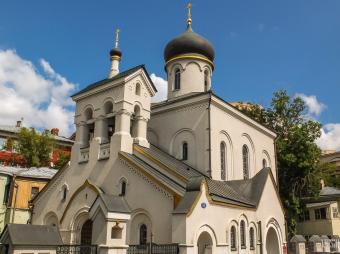
Intercession Old-Believers Church of the Ostozhenskaya Community
- 4 Turchaninov Pereulok
- http://www.ostogenka.ru/
On Turchaninov Pereulok off Ulitsa Ostozhenka is the Intercession Old-Believers Church of the Ostozhenskaya Community. The Ostozhenskaya Old-Believers Community was established in 1907 after Emperor Nicholas II's enactment of the law on religious tolerance. Construction of the Intercession Church began shortly afterwards and was completed in 1911. However it was closed by the Communists in 1932 and only returned to the Russian Orthodox Old-Rite Church in 1994. ►sights by… Read more »

Ivan Turgenev Museum
- 37/7 Ulitsa Ostozhenka
- http://www.pushkinmuseum.ru/?q=node/1
- 10:00 - 18:00 (Thursdays: 12:00 - 21:00). Closed Mondays, Tuesdays and the last Friday of the month.
The Ivan Turgenev Museum was opened in 2009 in the mansion where Turgenev's mother, Varvara Turgeneva, lived from 1840 to the 1850s and where the author was a frequent visitor. The museum has exhibitions which detail the life and the creative work of one of Russia's finest authors. The museum is run as a branch of the Aleksandr Pushkin State Museum. There is free admission to the museum on the third Sunday of the month. ►sights by districts ►sights in Khamovniki District Read more »

Multimedia Art Museum, Moscow
- 16 Ulitsa Ostozhenka
- Kropotkinskaya, Park Kultury
- http://www.mamm-mdf.ru
- 12:00 - 21:00. Closed on Mondays.
The Multimedia Art Museum, Moscow, or MAMM as it is known, was created in 2003 as part of the reorganisation of the museum of the House of Photography where the MAMM is based. The aim of the museum is to introduce people to contemporary art and multimedia technologies and it displays various photography and multimedia exhibitions by Russian and foreign artists. In addition the museum also holds festivals, lectures, film screenings and master-classes. There is free admission to the… Read more »
St Elijah the Prophet's Church on Obydensky Pereulok
- 6 2-y Obydensky Pereulok
- Kropotkinskaya
- http://www.hram-ostozhenka.ru/
St Elijah the Prophet's Church on Obydensky Pereulok, which is just off Ulitsa Ostozhenka, is often simply referred to as St Elijah Obydensky Church. The word Obydensky comes from the old-Russian for 'one day' as the first church to St Elijah was built here out of wood in one day in 1592. The current church dates from the turn of the 18th century and was built in the Petrine baroque style with a small dome on an 'octagon-on-cube' structure and a square bell tower. The church was… Read more »

Zachatievsky Convent
- 2-y Zachatievsky Pereulok
The Zachatievsky Convent was founded in 1584 and dedicated to the Conception ('zachatie') of St Anne. However previous to this there was another convent located here which was founded by St Alexius (Aleksey), Metropolitan of Moscow, in 1360 but destroyed by fire in 1547. Shortly after the Zachatievsky Convent was founded it was subjected to the destruction of the Times of Troubles. Major construction work took place at the convent in the late 17th, mid-18th and early 19th century… Read more »
Within the Garden Ring: Around Ulitsa Prechistka

'Burganov House' Moscow State Museum
- 15/9 Bolshaya Afanasievsky Pereulok
- http://www.burganov.ru
- 11:00 - 19:00
The 'Burganov House' Moscow State Museum was founded in 2001 by the sculptor Aleksandr Burganov, whose work can also be found decorating the streets of Moscow. The museum's main exhibits are located in the open-air courtyard outside and can be visited for free. There are also some halls inside, one entitled the Small Louvre and another Pegasus House, both displaying more work of the sculptor. ►sights by districts ►sights in Khamovniki District Read more »

Aleksandr Pushkin State Museum
- 12/2 Ulitsa Prechistenka
- http://www.pushkinmuseum.ru
- 10:00 - 18:00 (Thursdays: 12:00 - 21:00). Closed on Mondays and the last Friday of the month.
Not to be confused with the Pushkin State Museum of Fine Art, the Aleksandr Pushkin State Museum is dedicated to Russia's favourite poet and the age during which he lived. The museum was opened in 1957 in its current location in the 19th century Khruschyov-Seleznev Estate. In addition to the temporary exhibition hall and the conference hall, the museum has two permanent expositions dedicated: 'Pushkin and his Epoch' and 'Pushkin's Fairy Tales', which is aimed at children. There is… Read more »

Anna Golubkina Workshop-Museum
- 12 Bolshoy Lyovshinsky Pereulok
- Kropotkinskaya, Smolenskaya
- 12:00 - 19:00 (weekends: 10:00 - 17:00). Closed on Mondays, Tuesdays and the last Friday of the month.
Anna Golubkina was one of Russia’s most famous female sculptors. Her most famous work is the bas relief entitled 'The Wave' on the facade of the Moscow Art Academic Theatre (MKhAT) and she has other work on display at Moscow’s Tretyakov Gallery. This museum to her was opened in 1934, upon the initiative of her elder sister, in the workshop where Golubkina spend many years. Inside it includes a memorial room which has been retained as it was when Golubkina worked here. This museum… Read more »

Dormition Church on the Graves
- 2/2 Bolshoy Vlasievsky Pereulok
The Dormition Church on the Graves is located at the intersection of four streets and may have got it names due to it being surrounded by a graveyard, although other theories as to how it got its unusual name also exist. A Dormition Church has existed here since 1560 but the current version was built between 1791 and 1806. The church was designed by the French architect Nicolas Legrand and features a large central dome on a rotunda and two parallel bell towers over the tall church… Read more »

Fridtjof Nansen Monument
- 6c2 Bolshoy Lyovshinsky Pereulok
Standing next to the Moscow office of the Red Cross is a statue of Norwegian explorer, diplomat and Nobel Peace Prize laureate Fridtjof Nansen. Nansen is especially remembered in Russia due to his role in firstly helping First World War POWs leave Russia in 1920 during the chaos of the Russian Civil War and then by raising funds to tackle the massive humanitarian disaster which was the Russian famine of 1921. In the process the Nansen Passport was created which was identity cards… Read more »

Friedrich Engels Monument
- Ploschad Prechistenskie Vorota
Standing in the centre of Ploschad Prechistenskie Vorota opposite to Kropotkinskaya metro station is a statue of Friedrich Engels - the German philosopher and translator who, along with Karl Marx, is one of the founders of Communism. The monument was unveiled in 1976 and depicts the philosopher deep in thought with his arms crossed standing on a small pedestal. In the 1990s there were calls to have the statue removed, but it was saved on the orders of the then-mayor Yuri Luzhkov… Read more »
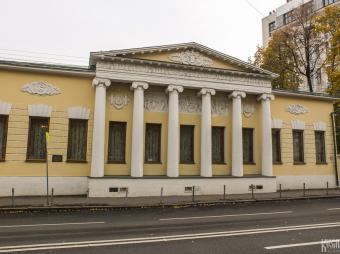
Lev Tolstoy State Museum: Literary Museum
- 11/8 Ulitsa Prechistenka
- http://www.tolstoymuseum.ru
- 10:00 - 18:00 (Thursday: 12:00 - 20:00). Closed on Mondays and the last Friday of the month.
The Lev Tolstoy State Museum, which was founded in 1911, has several departments in Moscow dedicated to the giant of Russian literature. Located on Prechistenka is the Literary Museum which is located in the 19th century Lopukhin-Stanitsky Mansion. Inside the museum has displays and exhibits detailing the life and work of the author, including several themed halls. In the garden there is also a statue of Lev Tolstoy. ►sights by districts ►sights in Khamovniki District Read more »

Russian Academy of Arts and Zurab Tsereteli Gallery
- 19 Ulitsa Prechistenka
- http://rah.ru/
- 12:00 - 20:00 (Friday: 12:00 - 22:00, Sunday 12:00 - 19:00). Closed on Mondays.
The Russian Academy of Arts has its headquarters on Ulitsa Prechistenka and it incorporates an art gallery which, apart from some ancient Roman and Greek statues, is dedicated to the work of the academy's current president - the controversial artist Zurab Tsereteli. The work of Tsereteli includes statues of well-known figures from Russian politics, Russian culture. and various tsars. Highlights include Vladimir Putin in his judo robe, former mayor of Moscow Yuri Luzhkov as a… Read more »
St Blaise's Church in Old Konyushennaya Sloboda
- 20 Gagarinsky Pereulok
The current version of St Blaise's Church in Old Konyushennaya Sloboda was first mentioned in 1644 although it is known that an older version stood here since at least 1625. The simple church comprises a single-domed structure attached to a small bell tower via a closed vestibule. During Napoleon's invasion the church was damaged to such an extent that it was re-consecrated after restoration work in 1815. In 1939 the church was closed and it fell into disrepair. It was restored in… Read more »

Vasili Surikov Monument
- 30 Ulitsa Prechistenka
Standing in a small square opposite to the building of the Russian Academy of Artists is a statue of the artist Vasili Surikov. Surikov worked in the 19th century and is most famous for his paintings depicting historical scenes such as 'Morning of the Streltsy's Execution', 'The Conquest of Siberia by Yermak' and 'Boyarynya Morozova'. The bronze monument was unveiled in 2003 and depicts Surikov standing next to his easel. ►sights by districts ►sights in Khamovniki District … Read more »
Within the Garden Ring: Around Ulitsa Volkhonka

Aleksandr Shilov Gallery
- 5 Ulitsa Znamenka
- Borovitskaya, Kropotkinskaya
- http://www.amshilov.ru/
- 11:00 - 19:00 (Thursday: 11:00 - 21:00). Closed on Mondays.
The Aleksandr Shilov Gallery is solely dedicated to the work of the portrait painter Aleksandr Shilov, who has painted prominent figures from Russian politics and culture as well as religious figures and war veterans. Although Shilov is undoubtedly popular among the ruling elite (and the staircase of the gallery proves this by being filled with photos of the artist posing with presidents, patriarchs, politicians and musicians), his work has been criticised by experts due to the… Read more »

Christ the Saviour Eparchial Cathedral
- 15 Ulitsa Volkhonka
- http://xxc.ru
The Christ the Saviour Cathedral is Russia's most important cathedral and its largest, having been designed to accommodate 10,000 people. The current version is actually the cathedral's second incarnation. Construction of the original version was started in 1839 under the project of the famous architect Konstantin Ton and the cathedral was consecrated 1883. However this version was famously demolished on the orders of Stalin in 1931. Afterwards there were plans to build an enormous… Read more »

Emperor Alexander II Monument
- 15 Ulitsa Volkhonka (in the park outside Christ the Saviour Cathedral)
Located in the park next to the Christ the Saviour Cathedral is a monument to Emperor Alexander II. The monument was unveiled in 2005. The pedestal reads "Abolished Serfdom in 1861 and freed millions of peasants from many centuries of slavery. Carried out military and legal reforms. Introduced a system of local self-government, city dumas and zemstvo boards. Ended the long Caucasian War. Freed Slavic people from the Ottoman Yoke. Died on 1 (13) March 1881 as a result of a terrorist… Read more »

Gallery of 19th and 20th Century European and American Art
- 14 Ulitsa Volkhonka
- http://www.newpaintart.ru
- 11:00 - 19:00 (Thursdays: 11:00 -19:00). Closed on Mondays.
Located in what was once the left-wing of the residence of the Princes Golitsyn is the Pushkin Museum of Fine Art's Gallery of 19th and 20th Century European and American Art, which opened its doors in 2006. The Museum has twenty-six rooms displaying work by various European and American masters including Caspar David Friedrich, Francisco de Goya, Claude Monet, Vasili Kandinsky, Vincent Van Gogh, Cezanne, Rousseau and Marc Chagall among many others. The museum is run as a… Read more »

Ilia Glazunov Moscow State Art Gallery
- 13 Ulitsa Volkhonka
- http://www.glazunov.ru/
The Ilia Glazunov Moscow State Art Gallery was opened in 2004 to display the work of the artist Ilia Glazunov. Glazunov is most known for his specific style and giant collages dedicated to various periods in Russian history. These collages, including his masterpiece 'Eternal Russia', are on display here in a special hall. Other paintings include his series dedicated to the Battle of Kulikovo Field, illustrations for classic Russian literature and poetry, and scenes from ancient… Read more »

Mikhail Sholokhov Monument
- Gogolevsky Bulvar
A few metres up Gogolevsky Bulvard is a wonderful monument to the author Mikhail Sholokhov, who is best known for his work 'And Quiet Flows the Don'. The monument was unveiled in 2007 and its centrepiece features a sculpture of the author sat in a boat which itself stands on a pedestal. However the best part of the sculpture is the waterfall feature behind it. The waterfall represents a river and just sticking out of the ground are the heads of many horses and one foal as if they… Read more »
Moscow Museum of Modern Art: Gogolevsky 10
- 10c1 Gogolevsky Bulvar
- http://www.mmoma.ru/
- 12:00 - 20:00 (Thursdays: 13:00 - 21:00). Closed on the third Monday of the month.
Immediately behind the Mikhail Sholokhov monument is an art gallery which is one of several galleries run by the Moscow Museum of Modern Art which was established in 1999. The museum is located in a late-18th century estate house which once belonged to the Tsurikov-Naryshkin family. Various art exhibitions are held here as well as conferences on various themes. There is free admission to the gallery on the third Sunday of the month. ►sights by districts ►sights in Khamovniki… Read more »

Museum of Private Collections
- 10 Ulitsa Volkhonka
- http://artprivatecollections.ru
The Museum of Private Collections was established in 1994 and it has been located in its present location in a specially-renovated mansion since 2005. The museum contains two floors of artwork all of which has been donated by private collectors of art. The collections have not been broken up and are displayed at the museum intact. The museum is run as a department of the Pushkin State Museum of Fine Arts. ►sights by districts ►sights in Khamovniki District Read more »
Nicholas Roerich Museum
- 3/5 Maly Znamensky Pereulok
- http://www.icr.su
- 11:00 - 19:00. Closed on Mondays.
The Nicholas Roerich Museum is located in the Lopukhin city estate which now houses the International Centre of the Roerichs and was set up in 1989 upon the initiative of the famous artist's son Svetoslav. The museum displays work of art of both Nicholas Roerich and his son George de Roerich, but also includes information on the Roerich family, including Nicholas Roerich's travels and his role in setting up the Roerich Pact which gives international protection to artistic and… Read more »

Pushkin Museum of Fine Arts
- 12 Ulitsa Volkhonka
- http://www.arts-museum.ru
- 10:00 - 19:00. Closed on Mondays.
The Pushkin Museum of Fine Arts is the largest museum of European art in Moscow and a must for art lovers. The initiative to open a museum of art in Moscow came from the professor Ivan Tsvetaev (father of the poet Marina Tsvetaeva) who managed to persuade millionaires to part with their cash in support. The museum eventually opened its doors in 1912 and was originally named after Emperor Alexander III. After the Revolution many works of art were transferred here from the Hermitage… Read more »
St Antipas' Church in Kolymazhny Courtyard
- 8 Kolymazhny Pereulok
- http://www.hramantipa.ru
St Antipas' Church in Kolymazhny Courtyard has a rather eclectic appearance as it has been added to several times over the centuries. There is some confusion as to when the original part dates from but most believe the 1560s. A legend exists that Malyuta Skuratov (Ivan the Terrible's henchman) was responsible for the addition of a side chapel to repent for his sins and some say he might even be buried here in his family's crypt. In the 18th century, side-chapels to St Nicholas and… Read more »
Plan your next trip to Russia
Ready-to-book tours.
Your holiday in Russia starts here. Choose and book your tour to Russia.
REQUEST A CUSTOMISED TRIP
Looking for something unique? Create the trip of your dreams with the help of our experts.

IMAGES
VIDEO
COMMENTS
K-Yacht Tekno Line 90. WAKE UP WITH NEW HORIZONS. K-Yacht Tekno Line motorhome, beautiful for elegance, performance and safety. Distinctive and modern lines that catch the eye. Streamlined and aerodynamic lines make travelling smooth and agile. A lead bar with a wide visual range for greater safety. Automotive design.
Find out more about K-Yacht Tekno Line interiors. EXTERIORS. ELEGANT EXTERIOR LINES, SPORTY CHARACTER. ... K-Yacht Tekno Line 89. K-Yacht Tekno Line 90. SEA Società Europea Autocaravan S.p.A, Socio unico, Cap.Soc. € 752.680,57 - C.F. - P.IVA: IT 03345730968 R.E.A. SIENA 121759, SEDE LEGALE - Via Val d'Aosta, 4 loc. Fosci IT - 53036 ...
TALIAN ELEGANCE. STANDING OUT IN STYLE. PERFECT INTERPRETER OF THE MOBILVETTA SPIRIT.Absolute pleasure of timeless elegance: K-Yacht Teknoline is the motorho...
Mobilvetta Design started life as a furniture manufacturer in Italy, this flair for modernistic looks continues into its RVs. Here we see the K Yacht 89 Te...
Mobilvetta Tekno Line K Yacht 59 2022. Mobilvetta Tekno Line K Yacht 59. £91,495. By Peter Baber. Published: May 25, 2022. This compact, couples-friendly motorhome benefits from some impressive touches, at a price that's right. This third bed is definitely not the nightmare jigsaw puzzle that many of these beds so often are. Motorhomes that ...
The Mobilvetta K-Yacht Tekno Line MH-80's front lounge includes a large, L-shaped settee, a good-sized table that slides in all directions, and a side seat. But there might be some squabbling about who has to sit on the inner of the two rear travel seats, because legroom there isn't generous. They won't want for entertainment, however.
The cooking area in the Mobilvetta K-Yacht Tekno Line MH-85 is one of the best we have seen in recent times. There is only a three-burner hob, but it is cleverly tucked into the corner, and there is a large sink with a cover that alternates as a chopping board and fits into a slot on a rail that runs along the top of the partition by the sink.
The 2021 version of the Mobilvetta Design K Yacht Tekno Line 89 comes at a cost of over EUR85k and with a queen bed in the back.
The three K-Yacht Tekno Line models marketed here include this 85 layout with fixed single beds over a garage. Competitively priced for an A-class, the K-Yacht comes with a high level of standard equipment, so there's no need for recourse to a lengthy options list. Its external styling is bold and distinctive - very Italian - while ...
Mobilvetta K-YACHT T-LINE 95/2. 2024 | A Class. Brand new | 2 berth | End lounge | Manual | 0.1L | 2 belted seats | L:7450 x W:2350 x H:2950. Trade Seller. Marquis Durham. Find Mobilvetta K-Yacht used motorhomes for sale on Auto Trader, today. With the best range of second hand Mobilvetta K-Yacht motorhomes across the UK, find the right ...
The K-Yacht Tekno Design seduces at first glance with its harmonious shapes, luxurious interiors and innovative yet functional materials. Available in three models , two versions with central bed ( 79 and 89 ) and twin beds ( 85 ), each K-Yacht Tekno Design motorhome offers unique moments in exclusive environments and the comfort of premium ...
YOUR WISHES HAVE MADE US GROW. K-Yacht Tekno Line offers a sleeping environment that goes at your own pace. Solutions for everyday living that suggest a new concept of comfort and relaxation. Maximum ventilation, protection in summer. Extra-large windows, 60x90 cm, skylight, flyscreen and blind. Fixed beds at the right height.
The multi award-winning Mobilvetta Tekno-Line is the ultimate in motorhome luxury featuring two unique and versatile ranges - the K.Yacht A Class and Kea Coachbuilt. Inside each Tekno Line motorhome Mobilvetta's expert designers have created the perfect fusion of traditional hand-crafted style furniture and contemporary Italian design.
K-YACHT Tekno Line MH-89 2018 Europa € 71.557,- // Nederland € 83.817,- // AFLEVERKLAAR Genoemde prijzen zijn Aflever-Klaar dus inclusief; Afleverklaar maken, Transport, Fabrieksgarantie, COC / CvO document en 21% BTW .
Find Mobilvetta K-Yacht Tekno Line used motorhomes for sale on Auto Trader, today. With the best range of second hand Mobilvetta K-Yacht Tekno Line motorhomes across the UK, find the right motorhome for you. ... 500 miles | Automatic | 0.2L | 4 belted seats | L:6.99 x W:2.35 x H:2.89. Trade Seller. Marquis Exeter; 40. £79,995. Mobilvetta K ...
3C, gli specialisti dei camper in Italia presenta:Mobilvetta K-Yacht 89 Tekno Line.LEGGI LA RECENSIONE!Clicca qui: https://3csrl.com/mobilvetta-teknoline-k-y...
From one of Italy's most prestigious motorhome builders the Mobilvetta K-Yacht 79 Tekno Line this compact A Class is packed with features and award winning design. Based on the ever popular Fiat Ducato chassis with the uprated to 4400kg. The engine is a 2.3 litre turbo diesel MultiJet giving 160bhp with the benefit of AdBlue for lower ...
Surprisingly, the luxurious boats are priced rather modestly, and a single ticket goes for $17-$32 (1,100-2,000 rubles); also expect a reasonable restaurant bill on top.
WAKE UP WITH NEW HORIZONS. K-Yacht Tekno Line motorhome, beautiful for elegance, performance and safety. Distinctive and modern lines that catch the eye. Streamlined and aerodynamic lines make travelling smooth and agile. A lead bar with a wide visual range for greater safety. Automotive design. Find out more about K-Yacht Tekno Line exteriors.
The window in Room 107 at the Hotel National faces Red Square and the Kremlin. It offers a perfect view of Lenin's tomb — fitting, since he was Room 107's most famous guest.
Sights in Khamovniki District. Moscow's central district of Khamovniki is situated directly south-west of the centre and south of the Arbat District within a curve of the River Moskva. Its is considered a rather elite district of Moscow. Its main streets are Ulitsa Volkhonka which branches off into Ulitsa Preschistenka and Ulitsa Ostozhenka.
On this map you can see the details of the longest and most classic of the Flotilla Radisson boat tours: 2. Companies that do boat tours on the Moskva River. There are many companies that do cruises on the Moskva River, but the 4 main ones are: Capital River Boat Tour Company (CCK) Mosflot. Flotilla Radisson.
Die K-Yacht Tekno Line vereint exklusives Design mit technologischem Fortschritt und setzt auf multifunktionale Relax-Bereiche für Schlafen und Wohnen mit besonders lichtdurchflutenden Innenbereichen in einem unverwechselbaren Stil. ... K-Yacht Tekno Line 89. K-Yacht Tekno Line 90. SEA Società Europea Autocaravan S.p.A, Socio unico, Cap.Soc ...